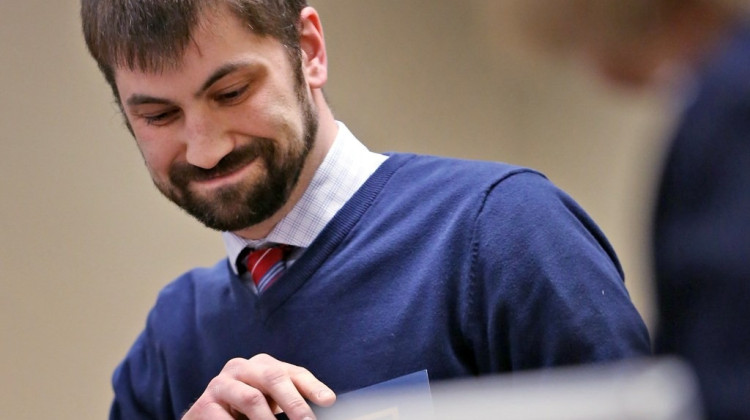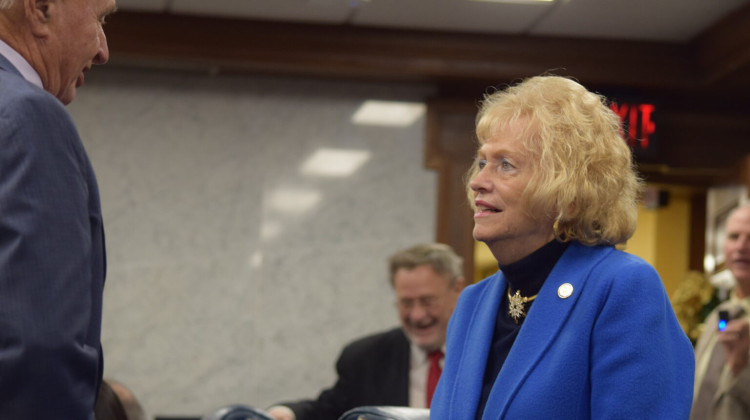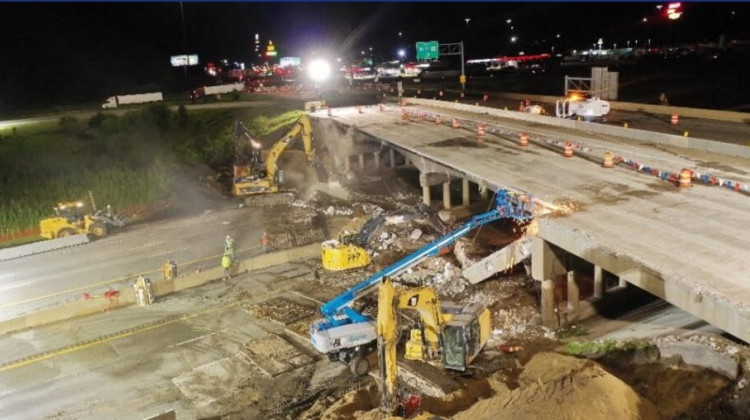
Duke Energy reported more than 150 power lines and 200 poles came down as a result of the storms. AES Indiana said, among other things, it had to replace 53 poles and repair 39 transformers.
Clayton Baumgarth/WTIUThe storms last week and weekend left some Hoosiers without power for days. Duke Energy and AES Indiana said they did their best to restore power after an unprecedented amount of damage.
But a consumer advocacy group said the utilities could have done more to prepare and wants the state to investigate the outages.
An unusual, widespread storm
The storms leading up to July 4 affected more than a third of customers with Duke Energy and about 20 percent with AES. One of those storms was declared a derecho — or a widespread, long-lived wind storm — by the National Weather Service.
Duke spokesperson Angeline Protogere said the storms were widespread and came in waves — which meant sometimes they would repair something like a power line only to have to repair it again later.
“We know that reliability of our service is probably the most important thing to our customers and it's the most important thing to us as well. This was a massive, unusual storm," she said.
Protogere said more than 150 power lines and 200 poles came down as a result of the storms. AES Indiana said, among other things, it had to replace 53 poles and repair 39 transformers.
Hoosiers pay for reliability, but advocates say there's little oversight
The consumer advocacy group, Citizens Action Coalition, encouraged Duke Energy and AES Indiana customers that went without power for days to file a complaint with the Indiana Utility Regulatory Commission.
While long power outages can be inconvenient for some, they can be life threatening for others — especially as temperatures climb in the summer. CAC Executive Director Kerwin Olson said these customers deserve to be compensated.
"Customers who have suffered over the course of three, four or five days with no energy where they've had hundreds, if not thousands of dollars of food spoil and medicine spoil," he said.
Olson said utilities should be doing more to prevent these prolonged outages — especially as Indiana continues to approve rate increases and pass legislation aimed at ensuring reliability.
“Those responsible for overseeing and regulating those utilities should hold them accountable when they don't deliver on what it is they tell folks they're going to do," he said.
Olson said the IURC doesn't have the right tools to hold utilities accountable — it's not allowed to impose fines, for example. What the agency can do, is an investigation.
In 2001, for example, AES Indiana — then called Indianapolis Power & Light — agreed to pay at least $877,000 to customers who were without power for more than 48 hours as a result of an IURC investigation into how the utility handled storms that July.
More often, Olson said the legislature makes it easier for utilities to more quickly recover the costs of things like transmission lines without considering all of a utilities revenue and expenses. This year, it also passed a number of laws CAC said favored utilities.
Among other things, Olson said Indiana should incentivize rooftop solar and make utility performance reviews available to the public to better ensure reliability.
Join the conversation and sign up for the Indiana Two-Way. Text "Indiana" to 73224. Your comments and questions in response to our weekly text help us find the answers you need on statewide issues, including this series on climate change and solutions.
Preventing outages and making a more resilient grid
Both Duke Energy and AES are in the middle of multi-year efforts to replace aging infrastructure and add technology to better isolate outages. Duke estimates that technology already prevented about 8,600 outages during these recent storms.
Andrew Phillips works for the collaborative non-profit research firm the Electric Power Research Institute (EPRI). He said as the U.S. moves toward electrifying cars and homes, the country is going to depend more on electricity — so it's important to make things like poles and lines resilient.
There are several ways to do that, he said. Things like building relationships with utilities in other states, replacing aging poles with stronger ones, or even moving some lines that are particularly vulnerable underground. Some of these AES and Duke are already doing.
Phillips said EPRI is also working with utilities to design power structures so that — when they fail — those failures are smaller and easier to recover from.
“It takes about 24 hours for a crew to come in, get another pole, set the pole, replace it — 24 hours. But imagine if we design it that instead of the pole breaking, that a piece of hardware breaks — or what we call the cross arm across the top breaks — and it takes about six hours to replace those," he said.
Kelly Young is the director of public relations for AES Indiana — which is about half way through a $1.2 billion plan to modernize its infrastructure. She said the utility is following through all of its plans as required.
“We still have a lot of work to do and we’re seeing some improvements that we’ve already made and looking forward to continuing that," Young said.
Rebecca is our energy and environment reporter. Contact her at rthiele@iu.edu or follow her on Twitter at @beckythiele.
9(MDAyMzk1MzA4MDE2MjY3OTY1MjM5ZDJjYQ000))
 DONATE
DONATE






 Support WFYI. We can't do it without you.
Support WFYI. We can't do it without you.